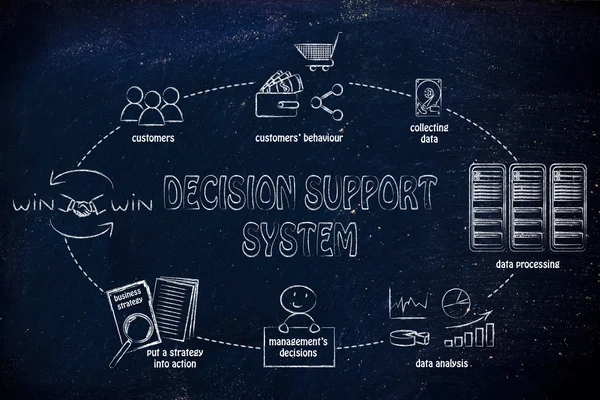
Exploring Decision Support Systems: Types, Advantages, and How to Utilize Them

A Decision Support System (DSS) is a computerized tool that helps organizations make informed decisions It is adaptable, easy to use, accurate, and timely DSS can be communication-driven, data-driven, document-driven, knowledge-driven, or model-driven It has a knowledge base, software system, and user interface DSS has advantages and disadvantages, and examples include financial, marketing, sales, operational, and human resources decision support DSS...
A computerized system called a decision support system (DSS) aids decision-making in organizations. It provides managers and other decision-makers with relevant information, models, and analysis tools to solve problems effectively. Depending on the specific problem, DSSs can be utilized in various ways such as planning production levels, tracking inventory levels, and even making automated decisions like routing phone calls or scheduling employees.
A decision support system refers to a computer program that analyzes data and presents it in a manner that aids in decision-making. These systems can be utilized by both humans and artificial intelligence (AI) agents.
What is a Decision Support System?
A DSS is designed to tackle a particular problem by processing large amounts of data and presenting comprehensive insights, empowering decision-making and issue resolution.
Understanding a Decision Support System
A decision support system is a tool that merges and evaluates data to generate comprehensive reports with valuable insights. Unlike regular operational programs that only gather data, a DSS is an informational application that also analyzes it to provide useful recommendations.
Depending on the situation, a DSS may be fully automated or require human input. The best systems go beyond providing information and make decisions for the user based on thorough data analysis. This empowers human users to make better and faster judgments, enhancing their decision-making capabilities.
Purpose of a Decision Support System
The complexity of a Decision Support System varies according to the problem it aims to solve. Some DSS are designed to support personal knowledge, while others use internal company data, comparative sales figures, operations-related data, or project management. Thus, the level of complexity is determined by the specific area of support.
A Decision Support System serves multiple purposes, with the primary objective of assisting decision-makers in their decision-making process by providing them with relevant information. These systems are versatile and can be utilized to address a wide range of problems.
For example, a Decision Support System may be used to:
- Help plan production levels
- Track inventory levels
- Make decisions automatically, such as routing phone calls or scheduling employees
Attributes of a DSS
1. Adaptability and flexibility
Decision support systems should have the ability to be utilized in various scenarios, making adaptability a crucial aspect. Additionally, these systems must be customizable to cater to the unique requirements of an organization.
2. Ease of use
Decision support systems should be easy to use so that they can be used by people who are not experts in computer science or data analysis.
3. Accuracy
Decision support systems must be accurate so that they can provide decision-makers with reliable information.
4. Timeliness
Decision support systems must be able to provide information in a timely manner so that decision-makers can make decisions quickly.
5. Support for modeling and analysis
Decision support systems should provide modeling and analysis tools so that decision-makers can test different scenarios and see the potential consequences of their decisions.
6. Complete control by decision-makers
Decision support systems should give decision-makers complete control over the information that they receive and the decisions that are made.
Types of Decision Support System Categories
There are several 5 types of classification of Decision Support Systems, including
1. Communication-driven DSS
Communication-driven DSSs are commonly utilized by internal teams such as partners to enhance collaboration and facilitate meetings. The most commonly used technology for implementing these DSSs is either web-based or client-server based. Some examples of this technology include chat and instant messaging software, online collaboration tools, and net-meeting systems.
2. Data-driven DSS
Data-driven decision support systems commonly target managers, workers, and product/service suppliers. These systems utilize database or data warehouse queries to obtain specific answers for particular purposes. They are delivered through various channels, such as mainframe systems, client/server connections, or the web. These computer-based databases incorporate data to enhance their current functionality and include a query system for evaluation.
3. Document-driven DSS
Document-driven decision support systems (DSSs) are widely used among various users compared to desktop software. They are specifically designed to search for specific keywords or search terms on internet pages. Typically, these systems are set up through a web-based platform or a client/server architecture.
4. Knowledge-driven DSS
Knowledgebases, also known as knowledge-driven DSSs, encompass a wide range of systems used by both internal users and external parties such as customers. These systems provide management advice and assist with selecting products or services. Common deployment technologies for knowledgebases include silent/server systems, the web, and software running on stand-alone PCs.
5. Model-driven DSS
DSSs that incorporate models to facilitate decision-making are advanced systems that allow for the analysis of options and the selection of alternatives. Depending on the design of the model, managers, personnel, and external stakeholders of a company may utilize these DSSs for a range of purposes, such as scheduling and decision analysis. These DSSs can be implemented on stand-alone PCs, client/server platforms, or the internet, and are commonly referred to as software/hardware solutions.
Decision Support System Components
Three key components of decision support systems are
1. Knowledge base
The Decision Support System relies heavily on its knowledge base to provide the necessary data and information needed for decision-making. This knowledge can take various forms such as rules, cases, heuristics, or any other type of knowledge that can support the decision-making process.
2. Software system
The software system plays a crucial role in facilitating access to the knowledge base data by offering a range of tools and interfaces. These tools comprise data mining algorithms, statistical analysis tools, optimization techniques, among others.
3. User interface
The ease of use and clarity of the user interface is crucial for the success of any Decision Support System. The interface should be designed with the end user in mind, ensuring that it is intuitive and easy to navigate. This could include a variety of interfaces, such as graphical user interfaces or web-based interfaces.
How to use a Decision Support System
Organizations can utilize decision support systems in various ways, depending on their specific requirements and the functionalities of the system. These systems can cater to individual or group usage and can be accessed through web or mobile platforms, ensuring accessibility for all organizations. To fully utilize the benefits of decision support systems, organizations must identify the capabilities of their chosen system and determine how it can best address their needs. These systems can be employed for a range of purposes like marketing, sales, operational management, human resources, education, healthcare, military, environmental, and sustainable development. As each decision support system offers its unique advantages and limitations, it is vital for organizations to select a system that aligns with their specific demands.
Decision support systems are created to assist organizations in making improved decisions, but they are not infallible and cannot always provide the optimal solution to a problem. These systems offer advice and recommendations based on the information fed into them. It is crucial to note that decision support systems do not aim to replace human decision-makers, but rather to augment their decision-making abilities.
It is vital to bear in mind that the quality of data inputted into the system determines the effectiveness of the decision support system. For the system to be useful, the data must be precise and up-to-date. Decision support systems are not meant to take the place of human judgment, but rather to add value to it.
Characteristics of a DSS
A Decision Support System has several key characteristics which are listed below:
- Interactive computer-based systems.
- Use data from a variety of sources.
- Provide information and advice to decision-makers.
- Outputs are tailored to the needs of the decision-maker.
- Flexible and can be adapted to changing needs.
- Intended to supplement, not replace, human judgment.
Advantages of Decision Support Systems
There are several advantages of using a decision support model management system such as-
- Help organizations make better decisions.
- Let organizations save time and money.
- Enable organizations to improve their performance.
- Help organizations make more informed decisions.
- Reduce the risk of making incorrect decisions.
Disadvantages of Decision Support Systems
There are several disadvantages of using decision support systems, which are listed below:
- Can be expensive to develop and maintain.
- They may also be complex and difficult to use.
- May require a lot of data to be inputted, which can be time-consuming.
The effectiveness of decision support systems may depend on the accuracy and relevance of the data being inputted. Therefore, it is crucial to carefully consider the pros and cons of utilizing such systems and select one that aligns with the unique requirements of the organization.
Examples of Decision Support System
Some of the popular decision support systems used in different types of business models are
1. Financial Decision Support
Decision support systems can be implemented through various channels, such as stand-alone applications, web-based platforms, and mobile apps. Stand-alone DSSs are primarily intended for individual or small group use, whereas web-based and mobile DSSs are more suitable for use by larger organizations.
2. Marketing Decision Support
Marketing decision support systems (MDSS) aim to assist organizations in making informed decisions by analyzing customer data, external information, and market trends. By doing so, businesses can gain a better understanding of which products or services to offer, how to price them appropriately, and where to sell them for maximum profitability.
3. Sales Decision Support
Sales organizations can greatly benefit from Sales Decision Support Systems (SDSS) which are specifically designed to enhance their decision-making process. By collecting and analyzing data on customer behavior and market trends, SDSS can provide valuable insights on what products or services to offer, when to offer them, and how to price them effectively.
4. Operational Decision Support
Decision support systems like ODSS are instrumental in providing organizations with the necessary tools to analyze data and optimize their operations. By effectively evaluating data, organizations can gain insights into how to improve their processes and enhance their overall performance.
5. Human Resources Decision Support
Organizations can benefit from HRDSS by gaining insights into their workforce and using data-driven decision-making to improve their human resource processes. This includes analyzing employee skills, experience, performance, and compensation data to make informed decisions. Additionally, decision support systems can be used to automate various organizational processes, such as GPS route planning, clinical decision support systems, crop-planning, and enterprise resource planning.
Decision support systems vs. business intelligence systems
Although decision support systems and business intelligence systems share the common goal of aiding organizations in making better decisions, they have distinct differences. Decision support systems are tailored to help organizations in making specific decisions, while business intelligence systems provide more generalized insights into the overall operations of the business.
Decision support systems are tailored to meet the specific needs of an organization, whereas business intelligence systems are more broad in scope and can be utilized by any organization. Decision support systems rely on existing data within the organization, while business intelligence systems require the gathering of new data. Additionally, decision support systems are primarily utilized by a select group of individuals within the organization, while business intelligence systems are utilized by a larger group of individuals.
Decision support system software
Some of the popular decision support system software are-
- QlikView
- Information Builders WebFOCUS
- Salesforce Analytics Cloud
- Powernoodle
- Briq
- SAP BusinessObjects
- TIBCO Spotfire, etc
How to choose a DSS?
Now that we know what Decision Support Systems are, let’s look at how to choose the right one for your organization-
Before choosing a Decision Support System, it's important to assess the unique requirements of your organization. This involves identifying the specific types of decisions you'll need to make and narrowing down your search to systems that cater to those needs. Additionally, it's crucial to factor in the size of your organization and the amount of data you have at your disposal. If you have a large volume of data, it's essential to opt for a system that can effectively manage and analyze it. On the other hand, if your organization is relatively small, you may not require a complex Decision Support System.
Once you have carefully evaluated these aspects, you can streamline your search and focus on a handful of Decision Support Systems that are tailored to your unique requirements. Once you have shortlisted these options, it's time to put them to the test and select the one that aligns seamlessly with your organizational goals.
Conclusion
Share your thoughts on the significance of Decision Support Systems for organizations. These systems provide data-driven recommendations and solutions for various purposes, including GPS routing, crop planning, clinical decision support, and ERP.








